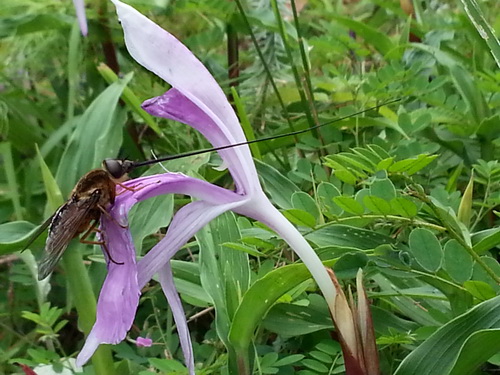The genus Roscoea is an alpine ginger group endemic to the Himalayan regions. It exhibits the suites of floral traits that would fit pollination by long tongued insects. However, previous studies found that the original pollinator of Roscoea were long-tongued insects, which have been lost from North Indochina due to recent climate change that occurred in the Chinese Himalayas. The absence of specialized pollinator is a serious threat to the Humalayan endemic alpine gingers.
Prof. LI Qingjun and his team of Xishuangbanna Tropical Botanical Garden (XTBG) studied the pollination biology of Himalayan Roscoea in the Nepalese Himalayas for four consecutive years (from 2012 to 2015). They aimed to find the effective pollinator of Roscoea purpurea at the center of evolution of Roscoea.
The researchers broadly investigated the floral visitors of R. purpurea and behavior of P. Longirostris and evaluated the pollination efficiency of P. longirostris. They also conducted artificial pollination experiments to see how R. purpurea reproduced in natural condition. They tested whether long-tongued fly acted as effective pollinator of the alpine ginger in Nepal Himalayas. They finally asked whether R. purpurea and P. longirostris showed obligate mutualism for their co-occurrence, survival and/or reproduction.
The study found that the partnership between R. purpurea and P. longirostris was an extremely obligate win-win situation in which plant gets reliable pollination service while fly gets secure reward. R. purpurea was exclusively pollinated by P. Longirostris, while P. longirostris did not get any alternative food source and thus exclusively relied upon R. purpurea. The results showed that R. purpurea was not capable of autonomous self-pollination and apomixis, and completely relied on pollinators for pollination success. The natural fruit set in R. purpurea was severely affected by pollen limitation, but seed set had no effect of pollen limitation. The finding of P. longirostris as an obligate and extremely specialized pollinator of Roscoea at its evolutionary center indicated that selection by long-tongued fly was one of the major factors of evolution/speciation of Roscoea in the Himalayas.
The study entitled “Out of Africa: evidence of the obligate mutualism between long corolla tubed plant and long tongued fly in the Himalayas” has been featured as cover story of Ecology and Evolution in November. The editorial board considered the finding as “a great example of how intricate relationship exists between plants and their pollinators in the natural ecosystems”.
Contact
LI Qingjun, Ph.D Principal Investigator
Key Laboratory of Tropical Forest Ecology, Xishuangbanna Tropical Botanical Garden, Chinese Academy of Sciences, Mengla, Yunnan 666303, China
Tel: 86-871-68125332
E-mail: lqj@xtbg.org.cn
 Himalayan endemic long corolla tubed alpine ginger, Roscoea purpurea and its obligate pollinator, a long tongued fly, Philoliche longirostris - Mutualism observed in Daman, Makawanpur, Nepal. (Image by Babu Ram Paudel) |

